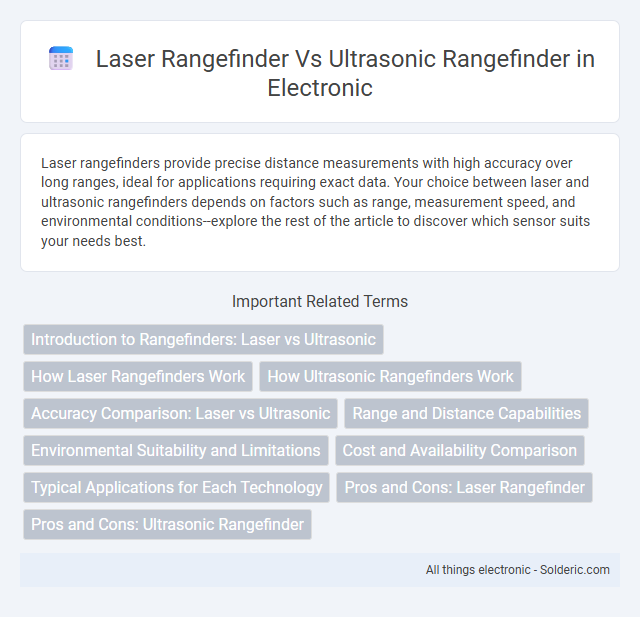Laser rangefinders provide precise distance measurements with high accuracy over long ranges, ideal for applications requiring exact data. Your choice between laser and ultrasonic rangefinders depends on factors such as range, measurement speed, and environmental conditions--explore the rest of the article to discover which sensor suits your needs best.
Comparison Table
| Feature | Laser Rangefinder | Ultrasonic Rangefinder |
|---|---|---|
| Measurement Method | Laser light pulse time of flight | Ultrasonic sound wave time of flight |
| Accuracy | High (+-1 to 3 mm) | Moderate (+-1 to 3 cm) |
| Range | Up to 2000 meters | Up to 10 meters |
| Response Time | Fast (milliseconds) | Moderate (tens to hundreds of milliseconds) |
| Environmental Sensitivity | Less affected by temperature, humidity; sensitive to fog, dust | Affected by temperature, humidity, and soft surfaces |
| Cost | Higher | Lower |
| Typical Applications | Construction, military targeting, surveying | Obstacle detection, robotics, indoor positioning |
| Size & Weight | Compact and lightweight | Generally bulkier |
Introduction to Rangefinders: Laser vs Ultrasonic
Laser rangefinders use coherent light beams to measure distances with high precision, making them ideal for applications requiring accurate long-range measurement up to several hundred meters. Ultrasonic rangefinders emit high-frequency sound waves to detect objects, offering cost-effective and reliable distance measurements for shorter ranges typically under 10 meters. The choice between laser and ultrasonic technology depends on factors such as measurement accuracy, range, environmental conditions, and budget constraints.
How Laser Rangefinders Work
Laser rangefinders work by emitting a laser beam toward a target and measuring the time it takes for the reflected light to return, using the speed of light to calculate precise distances. These devices offer high accuracy and fast response times, making them ideal for applications requiring detailed measurements, such as surveying or construction. Your choice of rangefinder impacts measurement precision, with laser technology typically outperforming ultrasonic sensors in range and reliability.
How Ultrasonic Rangefinders Work
Ultrasonic rangefinders measure distance by emitting high-frequency sound waves that travel until they hit an object and reflect back to the sensor, allowing the device to calculate the time taken and convert it into a distance measurement. These sensors are ideal for short to medium-range applications, offering accuracy in detecting objects in varying environments, including through transparent or dark surfaces where laser rangefinders might struggle. Your choice depends on the required distance range and environmental conditions, with ultrasonic technology excelling in cost-effectiveness and simplicity for precise close-range detection.
Accuracy Comparison: Laser vs Ultrasonic
Laser rangefinders deliver superior accuracy, often measuring distances within millimeters, making them ideal for precision tasks like surveying and construction. Ultrasonic rangefinders, while cost-effective and effective for shorter distances, typically have lower precision due to sound wave dispersion and environmental noise interference. Your choice should prioritize laser technology when exact measurements are critical, especially over longer ranges.
Range and Distance Capabilities
Laser rangefinders typically offer longer range and higher accuracy, measuring distances up to several hundred meters with precision within millimeters. Ultrasonic rangefinders are more limited in range, generally effective within 2 to 5 meters, and are less precise due to sound wave dispersion and environmental factors. The choice between these devices depends on the required measurement distance and accuracy for specific applications such as surveying or obstacle detection.
Environmental Suitability and Limitations
Laser rangefinders excel in open outdoor environments with long-distance measurements due to their high precision and minimal signal interference from wind or temperature fluctuations. Ultrasonic rangefinders perform better in indoor settings or short-range applications but can face accuracy issues in noisy or air-turbulent environments because sound waves are easily affected by obstacles and environmental conditions. Your choice should consider whether you need precise long-distance data in varied weather or simpler, short-distance measurements in controlled spaces.
Cost and Availability Comparison
Laser rangefinders typically have higher upfront costs compared to ultrasonic rangefinders, reflecting their advanced technology and greater precision. Ultrasonic sensors are widely available and generally more affordable, making them suitable for budget-conscious applications. Your choice depends on balancing cost constraints with the need for measurement accuracy and sensor availability.
Typical Applications for Each Technology
Laser rangefinders are commonly used in surveying, construction, and forestry for precise distance measurements over long ranges, often exceeding 100 meters with high accuracy. Ultrasonic rangefinders excel in robotics, automotive parking sensors, and indoor obstacle detection, offering reliable short to medium-range measurements typically within 4 to 10 meters. Laser technology is preferred for outdoor and line-of-sight applications, while ultrasonic sensors suit environments with irregular surfaces or where light-based measurement is impeded.
Pros and Cons: Laser Rangefinder
Laser rangefinders offer high accuracy and long-distance measurement capabilities, making them ideal for applications like surveying and hunting. They provide rapid readings and can function effectively in various lighting conditions but may struggle with reflective or transparent surfaces. Your choice of a laser rangefinder will depend on the need for precision versus cost, as they tend to be more expensive than ultrasonic models.
Pros and Cons: Ultrasonic Rangefinder
Ultrasonic rangefinders offer cost-effective distance measurement with simple implementation and reliable performance in short-range applications, typically up to 4-5 meters. They perform poorly in environments with soft or absorbent materials, as sound waves may scatter or be absorbed, leading to inaccurate readings. Ultrasonic sensors are also affected by environmental noise and temperature variations, which can reduce measurement accuracy compared to laser rangefinders.
Laser rangefinder vs ultrasonic rangefinder Infographic

 solderic.com
solderic.com